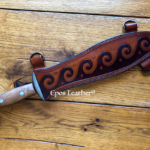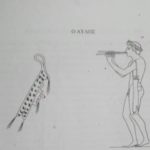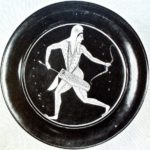Epos Custom Leather is proud to be associated with Koryvantes Historical Association. Our collaboration with Koryvantes allows us to recreate pieces of leather which have historical significance. While this can be challenging, we make each item as historically accurate as possible based on what knowledge is available.
The Association of Historical Studies “KORYVANTES is a Cultural Organisation , researching and applying experimentally the Military Heritage of the Greeks from the Bronze Age to the late Byzantium .
“Koryvantes” has participated in Academic conferences of Experimental Archaeology (University of Warsaw 2011, Academy of Pultusk 2012, University of Belgrade 2012, Organization Exarc / Denmark 2013 ), while studies have been published in academic literature (British Archaeology Report Series) and Special International Journals (Ancient Warfare Magazine ) .
They have also participated in major international TV Productions (History Channel, BBC2, BBC 4, ITV), on the thematic of the warfare and culture of ancient Greece.
You can learn more about what they do by visiting their website www.koryvantes.org
Bellow you can view some of our projects.
Scaled leather thorax
We are very proud to present to you this ancient Greek leather thorax that was crafted for the needs of the historical Association Koryvantes – Κορύβαντες. This project took a lot of studying and experimentation in order to be as historically accurate as possible. It is made out of vegetable tanned cowhide and took a little over 3,5 hides for its completion. It features 1056 leather scales that make the armor as thick at 1,8cm, whereas parts without scales like the belt, measure 0.7 cm thick. The chest has a hand carved and extreme embossed lion head, painted in dark shades in order to give it an antique look. We made two rows of pteryges, one with scales on the front and a plain leather row behind them to ensure more freedom of movement. The whole piece has been decorated with a meandros border that got antiqued for contrast.
It weighs 9 kg and it was tailored for a 1,7m tall man.
We have put a part of it to a blade test and we can’t wait to see how it will deal with arrows!
Scabbard for a Spartan short sword, ξυήλη
- Scabbard for a xeelee
Leather diavlos case, the ancient Greek pair of flutes
This case was created based on the depiction seen in the gallery bellow. It features a little pouch for the mouth pieces and a carving of the muse of music Euterpe, who is depicted playing that same instrument.
The Mycenaean Helmet
This Helmet was created using the picture of a Hittite fragment of a clay vessel from Bogazkoy dated around 1350 BC. In this image a warrior, who because of his general outfit has been interpreted by the scholars as one of the Ahhiyawa (Achaeans) warlord mentioned on several Hittite tablets, is equipped with an elaborate helmet probably made of interlaced leather strips, cheek and neck guards, one frontal horn, an upper tube with small crest in the lower area, and crest holder with long horse tail.
It was recreated using thick layers or leather over a leather support structure. No metal frame was used. The only metal parts used were copper rivets, in order to make it historically accurate. The front has a goat’s horn attached, and there is a ram’s horn on the top. Linen thread and copper wire was used to secure the hair of the horse’s tail on the back. The inside of the helmet has been lined with sheep’s skin (sheep’s fleece).
The Scythian Quiver
This quiver was created using a depiction on an ancient plate. We made sure to only use natural materials (bee’s wax, linen thread, vegetable tanned leather) in order to make it as historically accurate as possible. The size of this quiver was really challenging (85 cm long) as it had to fit the entire length of the arrows. The cover was made out of calf skin. The cover was used to keep the arrows dry when it rained.
This quiver has already traveled all around the world! Here you can see it during the WTAF 2015 (World Traditional Archery festival) in Korea.
The Scythian Hat
This hat was recreated using the following pictures of Scythian archers (circa 520/500 BC). While they were traditionally only made out of felt, we have reconstructed it our of thin calf skin, and lined the inside with many layers of felt.


